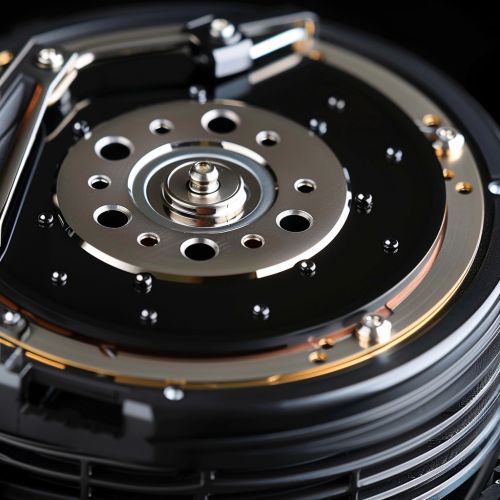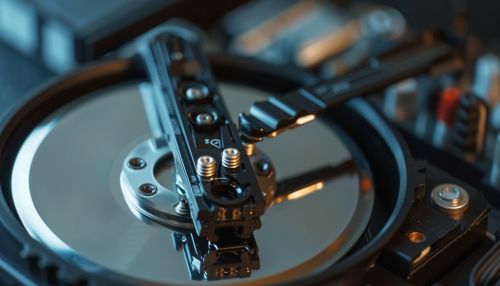Hard Disk Drive
Introduction
A hard disk drive (HDD) is a data storage device that uses magnetic storage to store and retrieve digital information using one or more rigid rapidly rotating disks (platters) coated with magnetic material. The platters are paired with magnetic heads, usually arranged on a moving actuator arm, which read and write data to the platter surfaces.


History
The hard disk drive was invented by IBM in 1953 for use in their 305 RAMAC computer system. The system used fifty 24-inch platters, with a total storage capacity of five million six-bit characters (3.75 megabytes). The term "hard disk drive" was first used in 1962, and has since become the most common term for a rigid disk drive.
Design and Operation
A hard disk drive consists of one or more platters, or disks, that are made of a rigid material, usually aluminum or glass, and are coated with a thin layer of magnetic material. The platters are mounted on a central spindle, and spin at high speeds, typically between 5400 and 15,000 revolutions per minute (RPM).
Data is stored on the platters in sectors, which are pie-shaped sections of the disk. Each sector holds a fixed amount of data, typically 512 bytes or, in newer drives, 4096 bytes. The sectors are arranged in tracks, which are concentric circles on the disk.
The data is read from and written to the disk by the read/write heads, which are tiny electromagnets mounted on the end of the actuator arm. The arm moves the heads across the disk surface, allowing them to access all of the sectors and tracks.
Data Encoding
Data is written to a hard disk drive by changing the magnetic orientation of tiny areas of the magnetic material on the disk. This is done by the write head, which generates a strong magnetic field that can orient the magnetic material in one of two directions, representing a binary 0 or 1.
The data is read by the read head, which detects the magnetic orientation of the areas of the disk. The read head generates a small electrical current when it passes over the magnetic areas, with the direction of the current indicating the binary value of the data.
The specific method of encoding the data on the disk can vary. The most common method used in modern drives is called perpendicular magnetic recording (PMR), which orients the magnetic areas vertically, or perpendicular to the disk surface. This allows for a higher data density than the older longitudinal recording method, which oriented the magnetic areas horizontally along the disk surface.
Performance
The performance of a hard disk drive is determined by several factors, including the rotational speed of the platters, the density of the data on the disk, the speed of the actuator arm, and the speed of the interface that connects the drive to the computer.
The rotational speed of the platters is one of the most important factors in the performance of a hard disk drive. Higher rotational speeds allow the read/write heads to access data more quickly, as the data passes under the heads more frequently.
The data density, or the amount of data that can be stored on a given area of the disk, also affects the performance of the drive. Higher data densities allow more data to be read or written on each rotation of the disk, increasing the data transfer rate.
The speed of the actuator arm affects how quickly the read/write heads can move from one track to another, which is important when reading or writing data that is not located in a single continuous block on the disk.
The speed of the interface that connects the drive to the computer also affects the performance of the drive. The interface must be able to transfer data to and from the drive at a rate that keeps up with the read/write operations of the drive.
Reliability and Failure
Hard disk drives are mechanical devices, and as such, they are subject to mechanical failure. The most common types of failure are head crashes and spindle motor failures.
A head crash occurs when the read/write heads come into contact with the surface of the platters. This can cause damage to the heads and/or the platters, resulting in data loss. Head crashes can be caused by shocks or vibrations, power failures, or wear and tear on the drive.
Spindle motor failures occur when the motor that spins the platters fails. This can prevent the drive from spinning up, making it impossible to read or write data. Spindle motor failures can be caused by wear and tear, power surges, or overheating.
In addition to mechanical failures, hard disk drives can also fail due to logical errors, such as file system corruption, or due to malware or other software issues.
